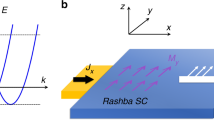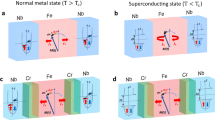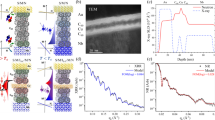Abstract
Unlike conventional spin-singlet Cooper pairs, spin-triplet pairs can carry spin1,2. Triplet supercurrents were discovered in Josephson junctions with metallic ferromagnet spacers, where spin transport can occur only within the ferromagnet and in conjunction with a charge current. Ferromagnetic resonance injects a pure spin current from a precessing ferromagnet into adjacent non-magnetic materials3,4. For spin-singlet pairing, the ferromagnetic resonance spin pumping efficiency decreases below the critical temperature (Tc) of a coupled superconductor5,6. Here we present ferromagnetic resonance experiments in which spin sink layers with strong spin–orbit coupling are added to the superconductor. Our results show that the induced spin currents, rather than being suppressed, are substantially larger in the superconducting state compared with the normal state; although further work is required to establish the details of the spin transport process, we show that this cannot be mediated by quasiparticles and is most likely a triplet pure spin supercurrent.
This is a preview of subscription content, access via your institution
Access options
Access Nature and 54 other Nature Portfolio journals
Get Nature+, our best-value online-access subscription
$29.99 / 30 days
cancel any time
Subscribe to this journal
Receive 12 print issues and online access
$259.00 per year
only $21.58 per issue
Buy this article
- Purchase on Springer Link
- Instant access to full article PDF
Prices may be subject to local taxes which are calculated during checkout



Similar content being viewed by others
References
Linder, J. & Robinson, J. W. A. Superconducting spintronics. Nat. Phys. 11, 307–315 (2015).
Eschrig, M. Spin-polarized supercurrents for spintronics: a review of current progress. Rep. Prog. Phys. 78, 104501 (2015).
Tserkovnyak, Y., Brataas, A., Bauer, G. E. W. & Halperin, B. I. Nonlocal magnetization dynamics in ferromagnetic heterostructures. Rev. Mod. Phys. 77, 1375–1421 (2005).
Ando, K. et al. Inverse spin-Hall effect induced by spin pumping in metallic system. J. Appl. Phys. 109, 103913 (2011).
Bell, C., Milikisyants, S., Huber, M. & Aarts, J. Spin dynamics in a superconductor–ferromagnet proximity system. Phys. Rev. Lett. 100, 047002 (2008).
Morten, J. P., Brataas, A., Bauer, G. E. W., Belzig, W. & Tserkovnyak, Y. Proximity-effect-assisted decay of spin currents in superconductors. Europhys. Lett. 84, 57008 (2008).
Beckmann, D. Spin manipulation in nanoscale superconductors. J. Phys. Condens. Matter 28, 163001 (2016).
Hübler, F., Wolf, M. J., Beckmann, D. & Löhneysen, H. v. Long-range spin-polarized quasiparticle transport in mesoscopic Al superconductors with a Zeeman splitting. Phys. Rev. Lett. 109, 207001 (2012).
Quay, C. H. L., Chevallier, D., Bena, C. & Aprili, M. Spin imbalance and spin-charge separation in a mesoscopic superconductor. Nat. Phys. 9, 84–88 (2013).
Wakamura, T., Hasegawa, N., Ohnishi, K., Niimi, Y. & Otani, Y. Spin injection into a superconductor with strong spin–orbit coupling. Phys. Rev. Lett. 112, 036602 (2014).
Yang, H., Yang, S.-H., Takahashi, S., Maekawa, S. & Parkin, S. S. P. Extremely long quasiparticle spin lifetimes in superconducting aluminium using MgO tunnel spin injectors. Nat. Mater. 9, 586–593 (2010).
Poli, N. et al. Spin injection and relaxation in a mesoscopic superconductor. Phys. Rev. Lett. 100, 136601 (2008).
Wakamura, T. et al. Quasiparticle-mediated spin Hall effect in a superconductor. Nat. Mater. 14, 675–678 (2015).
Inoue, M., Ichioka, M. & Adachi, H. Spin pumping into superconductors: A new probe of spin dynamics in a superconducting thin film. Phys. Rev. B 96, 024414 (2017).
Rojas-Sanchez, J. C. et al. Spin pumping and inverse spin Hall effect in platinum: the essential role of spin-memory loss at metallic interfaces. Phys. Rev. Lett. 112, 106602 (2014).
Gu, J. Y., Caballero, J. A., Slater, R. D., Loloee, R. & Pratt, W. P. Direct measurement of quasiparticle evanescent waves in a dirty superconductor. Phys. Rev. B 66, 140507 (2002).
Brataas, A., Nazarov, Y. V. & Bauer, G. E. W. Finite-element theory of transport in ferromagnet–normal metal systems. Phys. Rev. Lett. 84, 2481–2484 (2000).
Zhang, W., Han, W., Jiang, X., Yang, S.-H. & Parkin, S. S. P. Role of transparency of platinum–ferromagnet interfaces in determining the intrinsic magnitude of the spin Hall effect. Nat. Phys. 11, 496–502 (2015).
Villamor, E., Isasa, M., Hueso, L. E. & Casanova, F. Temperature dependence of spin polarization in ferromagnetic metals using lateral spin valves. Phys. Rev. B 88, 184411 (2013).
Flokstra, M. G. et al. Remotely induced magnetism in a normal metal using a superconducting spin-valve. Nat. Phys. 12, 57–61 (2016).
Ruggiero, S. T., Track, E. K., Prober, D. E., Arnold, G. B. & DeWeert, M. J. Electron tunneling in tantalum surface layers on niobium. Phys. Rev. B 34, 217–225 (1986).
Bell, C. et al. Proximity and Josephson effects in superconductor/antiferromagnetic Nb/gamma-Fe50Mn5 0 heterostructures. Phys. Rev. B 69, 109903 (2003).
Grein, R., Löfwander, T. & Eschrig, M. Inverse proximity effect and influence of disorder on triplet supercurrents in strongly spin-polarized ferromagnets. Phys. Rev. B 88, 054502 (2013).
Kalcheim, Y., Millo, O., Di Bernardo, A., Pal, A. & Robinson, J. W. A. Inverse proximity effect at superconductor-ferromagnet interfaces: Evidence for induced triplet pairing in the superconductor. Phys. Rev. B 92, 060501(R) (2015).
Di Bernardo, A. et al. Signature of magnetic-dependent gapless odd frequency states at superconductor/ferromagnet interfaces. Nat. Commun. 6, 8053 (2015).
Bergeret, F. S. & Tokatly, I. V. Spin–orbit coupling as a source of long-range triplet proximity effect in superconductor–ferromagnet hybrid structures. Phys. Rev. B 89, 134517 (2014).
Jacobsen, S. H., Kulagina, I. & Linder, J. Controlling superconducting spin flow with spin-flip immunity using a single homogeneous ferromagnet. Sci. Rep. 6, 23926 (2016).
Houzet, M. Ferromagnetic Josephson junction with precessing magnetization. Phys. Rev. Lett. 101, 057009 (2008).
Holmqvist, C., Teber, S. & Fogelström, M. Nonequilibrium effects in a Josephson junction coupled to a precessing spin. Phys. Rev. B 83, 104521 (2011).
König, R., Schindler, A. & Herrmannsdörfer, T. Superconductivity of compacted platinum powder at very low temperatures. Phys. Rev. Lett. 82, 4528–4531 (1999).
Tanaka, T. et al. Intrinsic spin Hall effect and orbital Hall effect in 4d and 5d transition metals. Phys. Rev. B 77, 165117 (2008).
Gubin, A. I., Il’in, K. S., Vitusevich, S. A., Siegel, M. & Klein, N. Dependence of magnetic penetration depth on the thickness of superconducting Nb thin films. Phys. Rev. B 72, 064503 (2005).
Acknowledgements
This work was supported by EPSRC Programme Grant EP/N017242/1.
Author information
Authors and Affiliations
Contributions
K.-R.J. and M.G.B. conceived and designed the experiments; the samples were prepared by K.-R.J., with help and the sputtering system provided by J.W.A.R. and M.G.B.; the FMR measurements were carried out by K.-R.J. with the help of C.C., H.K. and A.J.F.; the model calculation was performed by X.M. and M.E. and the data analysis was carried out by K.-R.J., C.C., H.K., J.W.A.R. and M.G.B.; all authors discussed the results and commented on the manuscript, which was written by K.-R.J. and M.G.B.
Corresponding authors
Ethics declarations
Competing interests
The authors declare no competing interests.
Supplementary information
Supplementary Information
Supplementary text, Supplementary Figures 1–12, Supplementary references
Rights and permissions
About this article
Cite this article
Jeon, KR., Ciccarelli, C., Ferguson, A.J. et al. Enhanced spin pumping into superconductors provides evidence for superconducting pure spin currents. Nature Mater 17, 499–503 (2018). https://doi.org/10.1038/s41563-018-0058-9
Received:
Accepted:
Published:
Issue Date:
DOI: https://doi.org/10.1038/s41563-018-0058-9
This article is cited by
-
Chiral antiferromagnetic Josephson junctions as spin-triplet supercurrent spin valves and d.c. SQUIDs
Nature Nanotechnology (2023)
-
Controlling spin pumping into superconducting Nb by proximity-induced spin-triplet Cooper pairs
Communications Physics (2023)
-
Spin-orbit driven superconducting proximity effects in Pt/Nb thin films
Nature Communications (2023)
-
Electrical detection of spin pumping in van der Waals ferromagnetic Cr2Ge2Te6 with low magnetic damping
Nature Communications (2023)
-
The superconducting diode effect
Nature Reviews Physics (2023)



